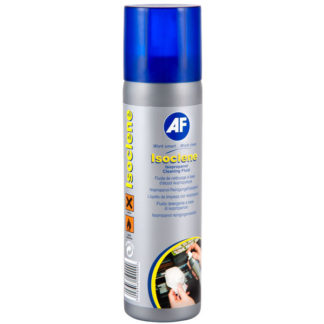Isopropanol
Isopropanol (also known as Isopropyl alcohol or "Iso" when blended with 5-30% water) is widely used in electronics and computing as a cleaning fluid. Water is the other general purpose solvent and Isopropyl will often work where water doesn't. Isopropyl has an affinity for grease and will temporarily dissolve it allowing it to be removed easily with tissue paper and cotton buds. It also dissolves many inks and adhesives.
Although it is called an alcohol, isopropyl isn't drinkable and will cause stomach pain and vomiting should anyone try. As the name implies it's derived from propane.
In computer maintenance isopropyl is often used as a general purpose cleaner for the insides of equipment, particularly where:
- greasy contaminants might be an issue - such as laser printer and inkjet electrical contacts
- where water droplets would cause problems - isopropyl quickly evaporates and can be used to "dry" water residues.
Isopropyl generally isn't quite as good as a damp cloth and detergent for cleaning the outside of equipment, it evaporates too quickly. There is also a risk that it will damage paint finishes although is is less likely to do so than acetone - sold as nail varnish remover. Another alternative solvent is methylated spirit (also known as denatured alcohol which is 90-95% ethanol plus methanol), used as a fuel for camping stoves, but this does leave a residue, and can damage some plastics.
Common uses are:
- Cleaning and Degreasing isopropyl is lipophilic and will thin most greases to the point where they can easily be removed
- Solvent for inks by thinning grease and wax components and evaporating more quickly than water makes isopropyl a valuable component of inks.
- Disinfectant most microorganisms cannot survive in isopropyl. Disinfectant pads usually contain a 70% solution. In 99% solution it can be used as an alternative to formaldehyde.
- Windscreen de-icer water dissolves and more easily dries in isopropyl. It can also be used in fuel lines to remove accumulated water and dissolve it in the fuel.
Related to the last points it's good for cleaning:
- Tape heads there can be sufficient liquid to displace grease and magnetite particles but it evaporates quickly so there is no rust or interference with the electronics
- Thermal paste from processors and other devices with a heatsink if the heatsink is to be changed.
- LCD and CRT screens (but be careful of anti-glare coatings)
- Lenses (but be careful of anti-glare coatings)
- Graffiti done with marker pens and lipstick
- Sticky label residues iso will often dissolve the glue.
- Soldering residues iso dissolves fluxes but doesn't delay testing of equipment.
Isopropyl is part of the technicians' tool kit for cleaning. The first approach is often a brush, next is a damp cloth with a touch of detergent and if those don't seem appropriate try a dab of iso. To remove pen marks and glue on the outside of a machine try a dab in an inconspicuous place first - it does sometimes strip paint.
Hazards.
The main dangers of using isopropyl in small quantities are that it is harmful if swallowed and flammable (hence the European Hazard symbols on bottles and cans). It should not come into contact with static electricity or sparks. It evaporates so quickly that these are not usually an issue for long, however that does suggest using it in a ventilated space. People must not drink it.
If you use isopropyl in any quantity eye and skin protection should be worn. In large quantities ventilation is needed. It will irritate the eyes. Skin contact will cause defatting with consequent contact dermatitis. However it is probably no worse in this respect than other alcohols and detergents and its use in disinfectant rubs and hand wipes suggests small quantities should not be a problem. Isopropyl can be absorbed through skin and metabolises to acetone but again a large exposure would be needed for a significant effect. If you regularly use large quantities of any chemical look at the relevant Material Safety Data Sheets.
Copyright G Huskinson & MindMachine Associates Ltd 2012

